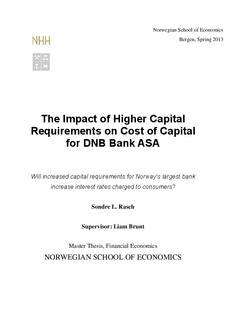The impact of higher capital requirements on cost of capital for DNB Bank ASA : will increased capital requirements for Norway’s largest bank increase interest rates charged to consumers?
Master thesis
Permanent lenke
http://hdl.handle.net/11250/170174Utgivelsesdato
2013Metadata
Vis full innførselSamlinger
- Master Thesis [4372]
Sammendrag
The financial crisis of 2007-2008 affected the financial sector worldwide. After the crisis, regulatory bodies and governments implemented stricter capital requirements for banks and financial institutions in order to cushion the impact of similar shocks in the future. In Norway the government aims to impose even stricter regulations than the Basel III-accord require. In opposition to the new rules DNB, Norway’s largest bank, claims the new rules will increase their capital cost and therefore increased their mortgage lending rates by 0,3 percentage points.
This paper aims at assessing the quantitative impact of higher primary capital in the capital structure of DNB Bank ASA. We intend to determine whether higher equity will lead to a higher cost of capital, which in turn will imply a higher interest rate on loans extended to customers. We will estimate DNBs capital structure under future Basel III standards and Norwegian legislation. We also estimate the effect of proposed Norwegian rules for stricter risk weighting of mortgages in DNBs assets. We apply the Capital Asset Pricing Model to calculate the regulations impact on the cost of capital for DNB Bank ASA under various scenarios.
We find that stricter capital requirements lead an increased cost of capital for DNB Bank ASA. Their cost of capital increases from 1.26 % under Basel III to 1.38 % if we introduce the new Norwegian RWA-rules and capital requirements. The effect of rising cost of capital for DNB Bank ASA is justified to lead to increased lending rates costs for consumers, but does not justify the magnitude of DNBs rate increase of 0.3 percentage points in March 2013.
